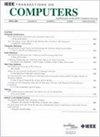GATe: Efficient Graph Attention Network Acceleration With Near-Memory Processing
IF 3.8
2区 计算机科学
Q2 COMPUTER SCIENCE, HARDWARE & ARCHITECTURE
引用次数: 0
Abstract
Graph Attention Network (GAT) has gained widespread adoption thanks to its exceptional performance in processing non-Euclidean graphs. The critical components of a GAT model involve aggregation and attention, which cause numerous main-memory access, occupying significant inference time. Recently, much research has proposed near-memory processing (NMP) architectures to accelerate aggregation. However, graph attention requires additional operations distinct from aggregation, making previous NMP architectures less suitable for supporting GAT, as they typically target aggregation-only workloads. In this paper, we propose GATe, a practical and efficient GAT accelerator with NMP architecture. To the best of our knowledge, this is the first time that accelerates both attention and aggregation computation on DIMM. We unify feature vector access to eliminate the two repetitive memory accesses to source nodes caused by the sequential phase-by-phase execution of attention and aggregation. Next, we refine the computation flow to reduce data dependencies in concatenation and softmax, which lowers on-chip memory usage and communication overhead. Additionally, we introduce a novel sharding method that enhances data reusability of high-degree nodes. Experiments show that GATe achieves substantial speedup of GAT attention and aggregation phases up to 6.77GATe:基于近记忆处理的高效图注意网络加速
图注意网络(GAT)由于其在处理非欧几里得图方面的优异性能而得到了广泛的应用。GAT模型的关键组件包括聚合和注意,它们会导致大量的主内存访问,占用大量的推理时间。最近,许多研究提出了近内存处理(NMP)架构来加速聚合。然而,图注意需要与聚合不同的额外操作,这使得以前的NMP体系结构不太适合支持GAT,因为它们通常只针对聚合工作负载。本文提出了一种实用高效的NMP结构GAT加速器GATe。据我们所知,这是第一次在DIMM上同时加速注意力和聚合计算。我们统一了特征向量访问,消除了由于注意和聚合的逐级顺序执行而导致的对源节点的两次重复内存访问。接下来,我们细化计算流,以减少连接和softmax中的数据依赖性,从而降低片上内存使用和通信开销。此外,我们还引入了一种新的分片方法,增强了高节点的数据可重用性。实验表明,与最先进的NMP作品GNNear和GraNDe相比,GATe实现了GAT注意力和聚合阶段的显著加速,分别达到6.77${\boldsymbol\times}$和2.46${\boldsymbol\times}$,平均分别达到3.69${\boldsymbol\times}$和2.24${\boldsymbol\times}$。
本文章由计算机程序翻译,如有差异,请以英文原文为准。
求助全文
约1分钟内获得全文
求助全文
来源期刊

IEEE Transactions on Computers
工程技术-工程:电子与电气
CiteScore
6.60
自引率
5.40%
发文量
199
审稿时长
6.0 months
期刊介绍:
The IEEE Transactions on Computers is a monthly publication with a wide distribution to researchers, developers, technical managers, and educators in the computer field. It publishes papers on research in areas of current interest to the readers. These areas include, but are not limited to, the following: a) computer organizations and architectures; b) operating systems, software systems, and communication protocols; c) real-time systems and embedded systems; d) digital devices, computer components, and interconnection networks; e) specification, design, prototyping, and testing methods and tools; f) performance, fault tolerance, reliability, security, and testability; g) case studies and experimental and theoretical evaluations; and h) new and important applications and trends.
 求助内容:
求助内容: 应助结果提醒方式:
应助结果提醒方式:


